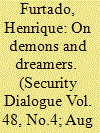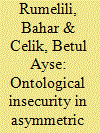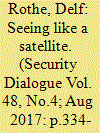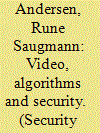|
|
|
Sort Order |
|
|
|
Items / Page
|
|
|
|
|
|
|
| Srl | Item |
| 1 |
ID:
154747


|
|
|
|
|
| Summary/Abstract |
Geoengineering technologies aim to make large-scale and deliberate interventions in the climate system possible. A typical framing is that researchers are exploring a ‘Plan B’ in case mitigation fails to avert dangerous climate change. Some options are thought to have the potential to alter the politics of climate change dramatically, yet in evaluating whether they might ultimately reduce climate risks, their political and security implications have so far not been given adequate prominence. This article puts forward what it calls the ‘security hazard’ and argues that this could be a crucial factor in determining whether a technology is able, ultimately, to reduce climate risks. Ideas about global governance of geoengineering rely on heroic assumptions about state rationality and a generally pacific international system. Moreover, if in a climate engineered world weather events become something certain states can be made directly responsible for, this may also negatively affect prospects for ‘Plan A’, i.e. an effective global agreement on mitigation.
|
|
|
|
|
|
|
|
|
|
|
|
|
|
|
|
| 2 |
ID:
154748


|
|
|
|
|
| Summary/Abstract |
Measures towards post-conflict or post-authoritarian justice have historically relied on the merging of the concepts of silence, violence and impunity in order to create a single promise of justice. Scholars and practitioners in the field usually defend a trifold agenda of breaking the silence about violations of human rights, denouncing systematic violence in the past and fighting impunity as the only way of ensuring that violence never happens again. This trope was mobilized in Brazil in 2014, when the report of the country’s National Truth Commission (CNV) was released. However, in the Brazilian case, truth-seeking also produced its own form of ‘silence’. Whereas the CNV commendably denounced 377 perpetrators as the ‘demons’ responsible for implementing a state of terror during the last dictatorship (1964–1985), it also created a depoliticized and victimized idea of leftist militants as mere dreamers who fought for liberty and democracy in the past. By representing leftist militants as freedom fighters, the CNV silenced their fundamental ideas (and actions) regarding the concept of revolutionary violence and its radical programme of structural change. In this article, I provide an explanation that connects the CNV’s ‘silencing’ of this political project to the unreflective merging between the concepts of silence, violence and impunity in the literature. Via a narrative analysis of the CNV’s report and a critique of transitional justice debates, I argue that the silence on the political project of the radical left in Brazil echoes transitional justice’s silence about the complexities of violence in general.
|
|
|
|
|
|
|
|
|
|
|
|
|
|
|
|
| 3 |
ID:
154746


|
|
|
|
|
| Summary/Abstract |
This article contributes to the recent literature on ontological security in conflict studies by empirically investigating, through a case study of Turkey’s Kurdish issue, how ontological asymmetry complicates peace processes. Over time, all conflicts become embroiled in a set of self-conceptions and narratives vis-à-vis the Other, the maintenance of which becomes critical for ontological security. In ethnic conflicts, however, these conceptions and narratives also intersect with a fundamental ontological asymmetry, because such conflicts often pit state parties with secure existence against ethnic groups with contested status and illegitimate standing. We argue that peace processes are easier to initiate but harder to conclude in ontologically asymmetric conflicts. Accordingly, we find that during the 2009–2015 peace process in Turkey, ontological (in)security-induced dynamics presented themselves in cyclical patterns of ambitious peace initiatives receiving greater support among the Kurdish public but giving way, at the first sign of crisis, to a rapid and dramatic return to violence, which neither side acted to stem. Moreover, we underscore that ontologically asymmetric conflicts, such as Turkey’s Kurdish issue, are often characterized by a societal security dilemma, where the conditions of ontological security for one party undermine those of the other. Therefore, building consensus around a new shared peace narrative may not be possible or desirable, and a lasting solution to Turkey’s Kurdish issue depends on the development of an agonistic peace around coexisting, multiple and contestatory narratives.
|
|
|
|
|
|
|
|
|
|
|
|
|
|
|
|
| 4 |
ID:
154749


|
|
|
|
|
| Summary/Abstract |
The article furthers the debate on environmental security by highlighting the role of visual technologies such as satellite remote sensing in the construction of threats and risks. It provides a rereading of the critical literature on environmental security through the lens of Actor-Network Theory and argues for understanding environmental security as a form of ontological politics. A theoretical framework around the notion of visual assemblage is developed that accounts for the hybrid, socio-technical character of visual technologies like satellite remote sensing, and shows how these render environmental risks and threats visible, intelligible, and thereby governable. Equipped with this framework, the article traces the development of a visual assemblage of satellite remote sensing from the early days of the Cold War until today and reveals its close co-evolution with environmental security discourses and practices. Three major contemporary remote sensing projects are analyzed to reveal how this global visual assemblage enacts multiple versions of environmental security: as resilience of local populations and ecosystems, as a series of local risk factors that become manageable through market-based risk management, and through a ‘meteorology of security’ based on the collection, harmonization, and automated analysis of big (environmental) data from multiple sources.
|
|
|
|
|
|
|
|
|
|
|
|
|
|
|
|
| 5 |
ID:
154750


|
|
|
|
|
| Summary/Abstract |
Digital videos increasingly sustain new and older imagined communities (and enmities), and make battlefields, unfolding terror plots and emergencies public. Yet digital videos mediate security articulations following logics that are radically different from those of journalistically edited media, with consequences for how we should think of security articulation in new visual media. This article analyses how, in digital video, the combination of visible facts and the remediation logics of algorithmically governed video platforms – such as YouTube and Facebook – allow for new types of security articulations. It argues that digital video can be understood as a semiotic composite where the material semiotics of media technologies, calculated publics and spectators combines with the political semiotics of audio-visual media to condition how video articulations work as political agency. A powerful video-mediated security articulation, the #neda videos from the 2009 Iranian post-election crisis, illustrates how security articulation in digital video is not tied to the authority of a speaker and does not contain the promise of an immediate, illocutionary security effect. Drawing on securitization theory and Butler’s critique of speech act theory, this article understands such video articulations as post-sovereign security articulations.
|
|
|
|
|
|
|
|
|
|
|
|
|
|
|
|
|
|
|
|
|